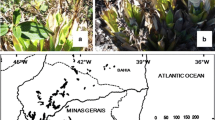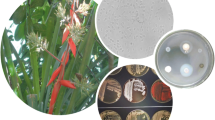Abstract
The basidiomycetous yeast Moesziomyces antarcticus (often cited as Pseudozyma antarctica), originally isolated from a sediment sample obtained from Lake Vanda in Antarctica, was asexually typified but closely related to the smut fungus Moesziomyces bullatus (Ustilaginales). We found a smut fungus on an ovary of barnyardgrass (Echinochloa crus-galli) in Japan, which had been identified as M. bullatus. The teliospores germinated and formed yeast-like colonies. Physiological and phylogenetic studies revealed that the characteristics of the yeast-like isolates coincided with those of “P. antarctica.” We thus recognised the smut fungus as the teleomorph of M. antarcticus, and then emended the description of M. antarcticus based on the holomorph. The identified fungus could degrade certain biodegradable plastics and produce mannosylerythritol lipids (MELs) in similar qualities as the “P. antarctica” type strain. This discovery provides a significant bioresource, as genetically diverse M. antarcticus isolates could be obtained from the smut fungus.





Similar content being viewed by others
References
Avis TJ, Caron SJ, Boekhout T et al (2001) Molecular and physiological analysis of the powdery mildew antagonist Pseudozyma flocculosa and related fungi. Phytopathology 91:249–254. https://doi.org/10.1094/PHYTO.2001.91.3.249
Barnett JA, Payne RW, Yarrow D (1983) Yeasts: characteristics and identification. Cambridge University Press, New York
Begerow D, Bauer R, Boekhout T (2000) Phylogenetic placements of ustilaginomycetous anamorphs as deduced from nuclear LSU rDNA sequences. Mycol Res 104:53–60. https://doi.org/10.1017/S0953756299001161
Bengtsson-Palme J, Ryberg M, Hartmann M et al (2013) Improved software detection and extraction of ITS1 and ITS2 from ribosomal ITS sequences of fungi and other eukaryotes for analysis of environmental sequencing data. Methods Ecol Evol 4:914–919. https://doi.org/10.1111/2041-210X.12073
Boekhout T (1995) Pseudozyma Bandoni emend. Boekhout, a genus for yeast-like anamorphs of Ustilaginales. J Gen Appl Microbiol 41:359–366. https://doi.org/10.2323/jgam.41.359
Boekhout T (2011) Pseudozyma Bandoni emend. Boekhout (1985) and a comparison with the yeast state of Ustilago maydis (De Candolle) Corda (1842). In: Kurtzman CP, Fell JW, Boekhout T (eds) The yeasts, a taxonomic study, Fifth edition, 5th edn. Elsevier, Amsterdam, pp 1857–1868
Chang MH, Kim HJ, Jahng KY, Hong SC (2008) The isolation and characterization of Pseudozyma sp. JCC 207, a novel producer of squalene. Appl Microbiol Biotechnol 78:963–972. https://doi.org/10.1007/s00253-008-1395-4
Goto S, Sugiyama J, Iizuka H (1969) A taxonomic study of Antarctic yeasts. Mycologia 61:748–774
Ikeda S, Fuji S, Sato T, Furuya H (2007) Microbial diversity in milled rice as revealed by riosomal intergenic spacer analysis. Microbes and Environments 22:165–174. https://doi.org/10.1264/jsme2.22.165
Ito S (1936) Mycological Flora of Japan, vol. 2, Basidiomycetes No. 1 Ustilaginales. Yokendo, Tokyo
Izumitsu K, Hatoh K, Sumita T et al (2012) Rapid and simple preparation of mushroom DNA directly from colonies and fruiting bodies for PCR. Mycoscience 53:396–401. https://doi.org/10.1007/s10267-012-0182-3
Kakishima M (1982) A taxonomic study on the Ustilaginales in Japan. Mem Inst Agric For-Univ Tsukuba Agric For Sci (Japan) 1:1–124
Kaspar M, Simmons GMJ, Parker BC et al (1982) Bryum Hedw. collected from Lake Vanda, Antarctica. Bryologist 85:424–430. https://doi.org/10.2307/3242912
Kitamoto D, Akiba S, Hiok C, Tabuchi T (1990) Extracellular accumulation of mannosylerythritol lipids by a strain of Candida antarctica. Agric Biol Chem 54:31–36. https://doi.org/10.1271/bbb1961.54.31
Kitamoto D, Ikegami T, Suzuki GT et al (2001) Microbial conversion of n-alkanes into glycolipid biosurfactants, mannosylerythritol lipids, by Pseudozyma (Candida antarctica). Biotech Lett 23:1709–1714. https://doi.org/10.1023/A:1012464717259
Kitamoto D, Morita T, Fukuoka T et al (2009) Self-assembling properties of glycolipid biosurfactants and their potential applications. Curr Opin Colloid Interface Sci 14:315–328
Kitamoto HK, Shinozaki Y, Cao X-H et al (2011) Phyllosphere yeasts rapidly break down biodegradable plastics. AMB Express 1:44. https://doi.org/10.1186/2191-0855-1-44
Kitamoto H, Yoshida S, Koitabashi M et al (2018) Enzymatic degradation of poly-butylene succinate-co-adipate film in rice husks by yeast Pseudozyma antarctica in indoor conditions. J Biosci Bioeng 125:199–204. https://doi.org/10.1016/j.jbiosc.2017.08.017
Kohata E, Kano R, Akune Y et al (2013) Environmental isolates of fungi from aquarium pools housing killer whales (Orcinus orca). Mycopathologia 176:403–408. https://doi.org/10.1007/s11046-013-9702-8
Koitabashi M, Noguchi MT, Sameshima-Yamashita Y et al (2012) Degradation of biodegradable plastic mulch films in soil environment by phylloplane fungi isolated from gramineous plants. AMB Express 2:40. https://doi.org/10.1186/2191-0855-2-40
Kruse J, Doehlemann G, Kemen E, Thines M (2017) Asexual and sexual morphs of Moesziomyces revisited. IMA Fungus 8:117–129. https://doi.org/10.5598/imafungus.2017.08.01.09
Liu X, Qiu X, Duan Z, et al (2018) A novel strain of Pseudozyma aphidis from mulberry parasitises the conidia of mulberry powdery mildew fungus Phyllactinia sp. and its biocontrol effect in the fields. Biocont Sci Technol 28:62–76. https://doi.org/10.1080/09583157.2017.1416067
Matheny PB, Gossmann JA, Zalar P et al (2006) Resolving the phylogenetic position of the Wallemiomycetes: an enigmatic major lineage of Basidiomycota. Can J Bot 84:1794–1805. https://doi.org/10.1139/b06-128
Min J, Hyun S, Kang M et al (2012) Isolation and identification of yeasts from wild flowers of Daejeon City and Chungcheongnam-do in Korea. Kor J Mycol 40:141–144
Molnár O, Wuczkowski M, Prillinger H (2008) Yeast biodiversity in the guts of several pests on maize; comparison of three methods: classical isolation, cloning and DGGE. Mycol Prog 7:111–123. https://doi.org/10.1007/s11557-008-0558-0
Moore RT (1987) Additions to the genus Vanrija. Bibliotheca Mycologica 108:167–173
Morita T, Konishi M, Fukuoka T et al (2007) Characterization of the genus Pseudozyma by the formation of glycolipid biosurfactants, mannosylerythritol lipids. FEMS Yeast Res 7:286–292. https://doi.org/10.1111/j.1567-1364.2006.00154.x
Morita T, Ito E, Kitamoto HK et al (2010) Identification of the gene PaEMT1 for biosynthesis of mannosylerythritol lipids in the basidiomycetous yeast Pseudozyma antarctica. Yeast 27:905–917. https://doi.org/10.1002/yea
Nilsson RH, Kristiansson E, Ryberg M et al (2008) Intraspecific ITS variability in the Kingdom Fungi as expressed in the international sequence databases and its implications for molecular species identification. Evol Bioinf 2008:193–201. https://doi.org/10.4137/EBO.S653
Orecchini LA, Olmos E, Taverna CG, et al (2015) First Latin American case of fungaemia due to Pseudozyma aphidis in a pediatric patient with osteosarcoma. J clin microbiol 53:3691–3694. https://doi.org/10.1128/JCM.01095-15
Piepenbring M (2003) Smut fungi:(Ustilaginomycetes PP and Microbotryales, Basidiomycota). New York Botanical Garden, New York
Qu J, Liu K, Ding X et al (2014) Fungal diversity and enzyme activities in marine sediments in the South China sea. Acta Microbiologica Sinica 54:552–562. https://doi.org/10.13343/j.cnki.wsxb.20170140
Rau U, Nguyen LA, Schulz S et al (2005) Formation and analysis of mannosylerythritol lipids secreted by Pseudozyma aphidis. Appl Microbiol Biotechnol 66:551–559. https://doi.org/10.1007/s00253-005-1906-5
Schoch CL, Seifert KA, Huhndorf S et al (2012) Nuclear ribosomal internal transcribed spacer (ITS) region as a universal DNA barcode marker for Fungi. Proc Natl Acad Sci 109:6241–6246. https://doi.org/10.1073/pnas.1117018109
Schröter J (1869) Die Brand- und Rostpilze Schlesiens. In: Abhandlungen der Schlesischen Gesellschaft für Vaterländische Cultur 1869/1872. Abteilung für Naturwissenschaften und Medicin. Breslau, pp 1–31
Schuster M, Schweizer G, Kahmann R (2017) Comparative analyses of secreted proteins in plant pathogenic smut fungi and related basidiomycetes. Fungal Genetics and Biology. https://doi.org/10.1016/j.fgb.2016.12.003
Scorzetti G, Fell JW (2002) Systematics of basidiomycetous yeasts: a comparison of large subunit D1/D2 and internal transcribed spacer rDNA regions. FEMS Yeast Res 1497:495–517. https://doi.org/10.1111/j.1567-1364.2002.tb00117.x
Selvi A, Das N (2014) Isolation, screening and identification of cefdinir degrading yeasts for the treatment of pharmaceutical wastewater. Int J Pharm Pharm Sci 6:382–386
Song X, Wang X, Tan Y et al (2015) High production of squalene using a newly isolated yeast-like strain Pseudozyma sp. SD301. J Agric Food Chem 63:8445–8451. https://doi.org/10.1021/acs.jafc.5b03539
Stoll M, Begerow D, Oberwinkler F (2005) Molecular phylogeny of Ustilago, Sporisorium, and related taxa based on combined analyses of rDNA sequences. Mycol Res 109:342–356. https://doi.org/10.1017/S0953756204002229
Sugita T, Nishikawa A, Ikeda R, Shinoda T (1999) Identification of medically relevant Trichosporon species based on sequences of internal transcribed spacer regions and construction of a database for Trichosporon identification. J Clin Microbiol 37:1985–1993
Sugita T, Takashima M, Poonwan N et al (2003) The first isolation of ustilaginomycetous anamorphic yeasts, Pseudozyma species, from patients’ blood and a description of two new species: P. parantarctica and P. thailandica. Microbiol Immunol 47:183–190. https://doi.org/10.1111/j.1348-0421.2003.tb03385.x
Sugiyama J, Sugiyama Y, Iizuka H, Torii T (1967) Report of the Japanese summer parties in dry valleys, Victoria Land, 1963–1965. IV. Mycological studies of the Antarctic fungi. Part. 2. Mycoflora of Lake Vanda, an ice-free lake. Antarct Rec (Tokyo) 28:23–32
Swofford DL (2002) PAUP*. Phylogenetic analysis using parsimony. Version 4. Sinauer Associates, Sunderland, Massachusetts. https://paup.phylosolutions.com
Tanaka E, Honda Y (2017) Teleomorph–anamorph connection of Macalpinomyces spermophorus with Pseudozyma tsukubaensis and corresponding erythritol production. Mycoscience 58:445–451. https://doi.org/10.1016/j.myc.2017.06.0061340-3540
Torii T, Yamagata N, Cho T (1967) Report of the Japanese summer parties in dry valleys, Victoria Land, 1963–1965. II. General description and water temperature data for the lakes
Torii T, Yamagata N, Nakaya S et al (1975) Geochemical aspects of the McMurdo Saline Lakes with special emphasis on the distribution of nutrient matters. Mem Natl Inst Polar Res Spec Iss 4:5–29
Vánky K (2012) Smut fungi of the world. APS Press, St. Paul
Wang Q-M, Begerow D, Groenewald M et al (2015) Multigene phylogeny and taxonomic revision of yeasts and related fungi in the Ustilaginomycotina. Stud Mycol 81:55–83. https://doi.org/10.1016/j.simyco.2015.10.004
Wei Y, Lee F, Hsu W et al (2005) Pseudozyma antarctica in Taiwan: a description based on morphological, physiological and molecular characteristics. Bot Bull Acad Sin 46:223–229
Wei Y, Liou G, Lee F (2011) Pseudozyma aphidis, a new record of ustilaginomycetous anamorphic fungi in Taiwan. Fungal Sci 26:1–5
Yamagata N, Torii T, Murata S (1967) Report of the Japanese summer parties in dry valleys, Victoria Land, 1963-1965. V. Chemical composition of lake waters. Antarct Rec (Tokyo) 29:53–57
Yarrow D (1998) Methods for the isolation, maintenance and identification of yeasts. In: The yeasts, 4th ed., A Taxonomic Study. Elsevier, pp 77–100
Yasuda F, Yamagishi D, IIzawa H, et al (2007) Fruit stain of Japanese pear caused by basidiomycetous, yeastlike fungi Meira geulakonigii and Pseudozyma aphidis. Jpn J Phytopathol 73:166–171
You W, Zou K, Yu X et al (2010) Isolation and identification of Ustilago esculenta and detection of plant hormones in the fermentation broth. Mycosystema 29:178–184
Acknowledgements
The authors are very grateful to Dr. Junta Sugiyama (Professor Emeritus, The University of Tokyo) for his kind advice of this article. We thank Dr. Shumpei Kitamura and Kanae Hoshi (Ishikawa Prefectural Univ.) who found the smut fungi. This work was not supported by particular fund.
Author information
Authors and Affiliations
Contributions
E. Tanaka and M. Koitabashi conceived of this study and prepared samples. E. Tanaka and H. Kitamoto performed experiments and analyzed data. E. Tanaka wrote the paper. All authors provided critical feedback, discussed the results and contributed to the final manuscript.
Corresponding author
Ethics declarations
Conflict of interest
The authors declare that they have no conflict of interest.
Electronic supplementary material
Below is the link to the electronic supplementary material.
Rights and permissions
About this article
Cite this article
Tanaka, E., Koitabashi, M. & Kitamoto, H. A teleomorph of the ustilaginalean yeast Moesziomyces antarcticus on barnyardgrass in Japan provides bioresources that degrade biodegradable plastics. Antonie van Leeuwenhoek 112, 599–614 (2019). https://doi.org/10.1007/s10482-018-1190-x
Received:
Accepted:
Published:
Issue Date:
DOI: https://doi.org/10.1007/s10482-018-1190-x




